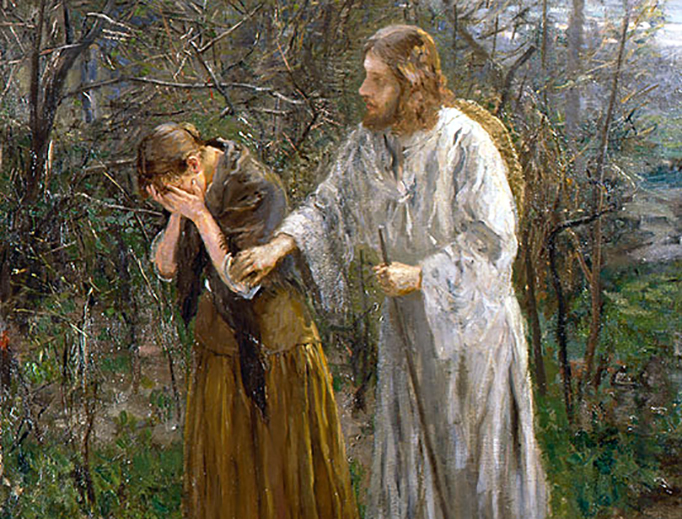Why Seek Ye the Living in the Culture of Death?
Instead of looking for Life behind rolled-away stones, we now seek it under rocks.

The conquest of death as the “last enemy” is a promise the Old Testament already proposes: Isaiah speaks of Yahweh “swallowing up death forever” (25:7b), while Hosea’s God promises to “deliver this people from the power of the grave (13:14). Ezekiel consoles Israel with resurrection in the valley of the bones (37:1-14), while the writer of Wisdom (1:13-15) assures us “God did not make death.” The whole theology is consummated in Paul’s correlation of Jesus’ Resurrection to ours, the first fruits that makes ours possible, letting him sing: “O death, where is your victory? O death, where is your sting?” (1 Corinthians 15:55).
Clearly, Saul of Tarsus did not subscribe to The New York Times.
On “the feast of victory for our God,” America’s paper of record treated its readers to an op-ed on “Decomposition: An Easter Story.”
Author Eugenia Bone “always start[s] thinking about decomposers around Easter. Christ’s body was said to have been untouched by decay when it was resurrected; but for the rest of us, the resurrection part of the life cycle is performed by decomposers.”
Whereas Antiquity was ready to identify God with the Divine nousor cosmic psyche, our thoroughly modern mycologist confesses a temptation to deify the lysosomes that break down in our cells once we shed this mortal coil. They release the hydrolytic enzymes that, in turn, break us down. “Though I admit, I myself am tempted to spiritualize decomposition. It kind of makes sense that God wouldn’t be one great huge entity, but actually billions and billions of microscopic ones” all apparently set on reducing His image and likeness to compost. But, in the end, she restrains her enthusiasm for worms and bacteria, admitting that “the truth is … decomposers are physical phenomena, mortal organisms like you and me. They may resurrect the essential ingredients of life, but they aren’t a miracle. They just feel like one.”
Karol Wojtyła, the future St. John Paul II, presciently told his predecessor, Pope Paul VI during the 1976 papal Lenten retreat that “we are in the front line of a lively battle for the dignity of man.” The struggle is between a Christian theological anthropology that sees man’s homeland beyond the physical world, death as something unnatural, and the most noble human aspiration as immortality versus a materialist vision that reduces man to the physical — $4.95 of chemicals and a few gallons of water — death as “that’s all there is,” and the most noble human aspiration to be recycled as a probiotic. Last summer, the Times glowed about how a British crematory had partnered with the local pool so that heat from the former could be piped to warm the latter. Once “ashes to ashes, dust to dust” was the curse the human body sought to escape, rejoicing in being consecrated a temple of the Holy Spirit. Now that temple is reduced to ashes to find fulfillment in making swimsuit-clad bodies momentarily toasty.
Still, the quest for immortality asserts itself, if not in personal spiritual survival then at least as temporary anonymous post-mortem utility for others. Eastern reincarnation meets Western recycling.
The contemporary loss of a sense of personal immortality is both expressed in and abetted by the growing popularity of cremation. The Vatican’s 2016 instruction reaffirming the Church’s preference for earth burial over cremation, to the extent anybody talked about it, has hardly dampened Catholic openness to cremation, which is hardly distinguishable from the general population. And while motives may be more economic than theological, the Church—at least in the United States—has yet to “accompany” its faithful into reducing the costs of Christian burial, all the while as diocesan cemetery commissions offer columbaria alongside crypts. Still, if the value of the Christian body is seen primarily through an economic rather than a theological prism, it won’t be long before other considerations enter in. Ecological consciousness is one such consideration: already, alkaline hydrolysis is being hawked as an alternative to traditional incineration—less carbon footprint, and the dilute can be discharged as wastewater. Again, it seems Oriental spirituality supplants Occidental: Teilhard’s Cosmic Christ and Rahner’s eschatological stardust have become Nirvana as effluent.
The threat to orthodox Christian faith is real. How I am dead is not so much a technical problem as a profession of faith. The communal Christian cemetery is not interchangeable with some unmarked sylvan glade: I do not want to be forgotten among the forget-me-nots. Mortal corruption is now no longer punishment but eco-friendly cosmic oneness. At the very least it makes unintelligible the angelic query “why seek ye the living among the dead?” Instead of looking for Life behind rolled-away stones, we now seek it under rocks.













